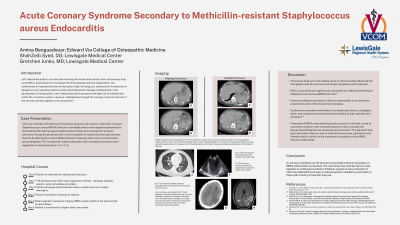Back

Medical Education
Acute Coronary Syndrome Secondary to Methicillin-Resistant Staphylococcus aureus Endocarditis
Friday, March 31, 2023
12:00 PM East Coast USA Time

- AB
Amina Benguedouar, DO
Edward Via College of Osteopathic Medicine
Fairfax, Virginia, United States - SS
ShahZeib Syed, DO
LewisGale Medical Center
Salem, Virginia, United States
Presenting Author(s)
Second Author(s)
Introduction: Left-sided endocarditis is an infection involving the mitral and/or aortic valve. There are roughly 10,000 to 15,000 cases of endocarditis per year. Injection drug use is associated with increased risk of developing endocarditis. Left-sided endocarditis presents with a high risk of embolization within the circulatory system, which remains the major concern of this condition. Embolization through the coronary ostia into the rest of the coronary system is uncommon. To the authors’ best knowledge, there are no demonstratable publications of a native mitral valve vegetation secondary to methicillin-resistant Staphylococcus aureus (MRSA) endocarditis as a cause for non-ST elevation myocardial infarction (NSTEMI) in injection drug users.
Case Study: A 34-year-old man with history of recent admission with MRSA bacteremia, injection drug use with cocaine, and mobile mitral valve vegetation presented to the hospital with chest pain. A toxicology screening was negative for cocaine use, however the patient’s chest pain and high troponin levels persisted. This persistence reflects NSTEMI. This case of NSTEMI is likely originating from mitral valve vegetation demonstrated during previous admissions. On multiple occasions, blood cultures were positive for MRSA, which was complicated by multiple septic emboli to the spleen, kidneys, subpleural space, and encephalopathy with left parietal-occipital lobe involvement. The patient was eventually escalated to a higher-level care center given his comorbidities and clinical picture for further management. NSTEMI due to mitral valve vegetations in the setting of MRSA is a rare complication of infective endocarditis.
Discussion: Given the high-risk nature of injection drug use, it is important to consider the complications that may result from infection. In a previously reported case study, a patient was afflicted by the same condition without a history of injection drug use; however, the patient’s condition was stable enough to pursue acute percutaneous intervention of the myocardial infarction. This presentation details how previously known and independent risks have coalesced to complicate and delay the necessary treatment of a patient. Therefore, it is important to highlight prompt treatment of infective endocarditis and explore strategies to increase compliance in patients, particularly those with a history of injection drug use. It is necessary to search beyond the illness and explore the patients’ circumstances to prevent and treat the development this condition.
Case Study: A 34-year-old man with history of recent admission with MRSA bacteremia, injection drug use with cocaine, and mobile mitral valve vegetation presented to the hospital with chest pain. A toxicology screening was negative for cocaine use, however the patient’s chest pain and high troponin levels persisted. This persistence reflects NSTEMI. This case of NSTEMI is likely originating from mitral valve vegetation demonstrated during previous admissions. On multiple occasions, blood cultures were positive for MRSA, which was complicated by multiple septic emboli to the spleen, kidneys, subpleural space, and encephalopathy with left parietal-occipital lobe involvement. The patient was eventually escalated to a higher-level care center given his comorbidities and clinical picture for further management. NSTEMI due to mitral valve vegetations in the setting of MRSA is a rare complication of infective endocarditis.
Discussion: Given the high-risk nature of injection drug use, it is important to consider the complications that may result from infection. In a previously reported case study, a patient was afflicted by the same condition without a history of injection drug use; however, the patient’s condition was stable enough to pursue acute percutaneous intervention of the myocardial infarction. This presentation details how previously known and independent risks have coalesced to complicate and delay the necessary treatment of a patient. Therefore, it is important to highlight prompt treatment of infective endocarditis and explore strategies to increase compliance in patients, particularly those with a history of injection drug use. It is necessary to search beyond the illness and explore the patients’ circumstances to prevent and treat the development this condition.
